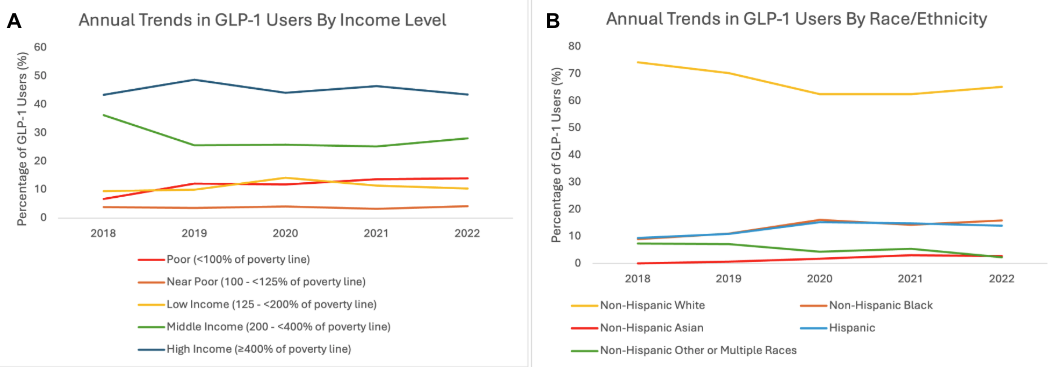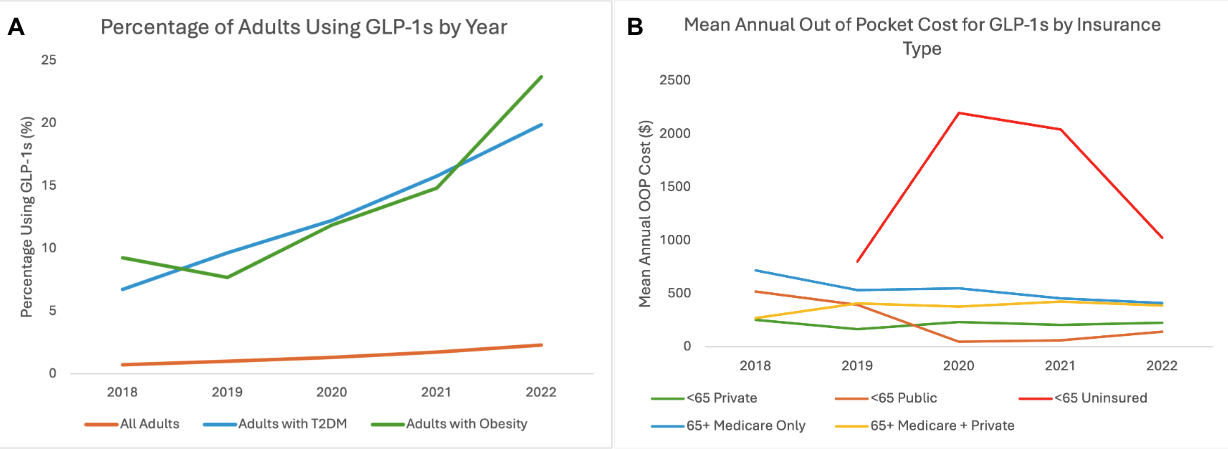Tuesday Poster Session
Category: Diet, Nutrition, and Obesity
P4851 - Nationwide Trends in GLP-1 Use: Examining Indications, Sociodemographics, and Cost Burden Using MEPS (2018-2022)
Tuesday, October 28, 2025
10:30 AM - 4:00 PM PDT
Location: Exhibit Hall

Erika Tsuchiyose, BA
Tufts University School of Medicine
Boston, MA
Presenting Author(s)
Erika Tsuchiyose, BA1, Erik Holzwanger, MD2
1Tufts University School of Medicine, Boston, MA; 2Tufts Medical Center, Boston, MA
Introduction: There is increasing discourse on glucagon-like peptide-1 receptor agonist (GLP-1) use in gastroenterology for conditions like steatotic liver disease or as adjuncts to endobariatric procedures. However, costs may impede equitable access. Using the most recent cycles of the Medical Expenditure Panel Survey (MEPS), a nationally representative survey on healthcare utilization, we aimed to describe trends in GLP-1 use from 2018-2022 and highlight differences in usage and cost by sociodemographic factors.
Methods: Using the latest 5 years of MEPS data (2018-2022), we conducted repeat cross-sectional analyses of adults (18+) who filled at least one GLP-1 prescription. Stata 18.0 software was used to assess weighted prevalence of GLP-1 use by indications, race/ethnicity, income, insurance type, as well as out-of-pocket (OOP) cost. Figures were created in Excel.
Results: Overall, GLP-1 use has steadily increased from 0.72% in 2018 to 2.30% in 2022. Among adults with type 2 diabetes mellitus (T2DM), usage increased from 6.73% to 19.88%. Although analysis of ICD-10 obesity codes was limited by small sample size, use doubled from 9.25% to 23.70%. Across all years, GLP-1 indications were mostly for T2DM (85.79-88.83%). Non-Hispanic white adults had the highest usage across all years (74.24% in 2018 and 65.20% in 2022), while non-Hispanic Black and Hispanic patients remained underrepresented. GLP-1 use was most prevalent in those with private insurance (52.61% in 2018 and 48.63% in 2022). As of 2022, uninsured patients had highest annual OOP costs at $1025.33 compared to $255.16 with private insurance and $413.11 with Medicare only.
Discussion: As GLP-1s gain traction in management for a growing number of conditions and their uses expand into GI and hepatology, their costs raise concerns of perpetuating existing health disparities. MEPS data demonstrates GLP-1 use is concentrated in high income, privately insured, non-Hispanic white patients despite minority and lower income groups facing the greatest burden of metabolic disease. While some articles describe GLP-1 disparities, few utilize nationwide databases. Self-reported data often overstates true prevalence, while MEPS provides a conservative estimate of GLP-1 utilization through pharmacy verified prescription fills, excluding compounded formulations or online retail. As insurance coverage evolves and new ways to access GLP-1s emerge, greater attention is needed to ensure equitable distribution.

Figure: Figure 1 A) Percentage using GLP-1s across all US adults, those with type 2 diabetes, and those with obesity from 2018 to 2022. B) Mean annual out of pocket cost for GLP-1 prescription fills by insurance type from 2018 to 2022.

Figure: Figure 2 A) Annual trends in GLP-1 users by income level from 2018 to 2022. B) Annual trends in GLP-1 users by race/ethnicity from 2018 to 2022.
Disclosures:
Erika Tsuchiyose indicated no relevant financial relationships.
Erik Holzwanger: Boston Scientific – Consultant.
Erika Tsuchiyose, BA1, Erik Holzwanger, MD2. P4851 - Nationwide Trends in GLP-1 Use: Examining Indications, Sociodemographics, and Cost Burden Using MEPS (2018-2022), ACG 2025 Annual Scientific Meeting Abstracts. Phoenix, AZ: American College of Gastroenterology.
1Tufts University School of Medicine, Boston, MA; 2Tufts Medical Center, Boston, MA
Introduction: There is increasing discourse on glucagon-like peptide-1 receptor agonist (GLP-1) use in gastroenterology for conditions like steatotic liver disease or as adjuncts to endobariatric procedures. However, costs may impede equitable access. Using the most recent cycles of the Medical Expenditure Panel Survey (MEPS), a nationally representative survey on healthcare utilization, we aimed to describe trends in GLP-1 use from 2018-2022 and highlight differences in usage and cost by sociodemographic factors.
Methods: Using the latest 5 years of MEPS data (2018-2022), we conducted repeat cross-sectional analyses of adults (18+) who filled at least one GLP-1 prescription. Stata 18.0 software was used to assess weighted prevalence of GLP-1 use by indications, race/ethnicity, income, insurance type, as well as out-of-pocket (OOP) cost. Figures were created in Excel.
Results: Overall, GLP-1 use has steadily increased from 0.72% in 2018 to 2.30% in 2022. Among adults with type 2 diabetes mellitus (T2DM), usage increased from 6.73% to 19.88%. Although analysis of ICD-10 obesity codes was limited by small sample size, use doubled from 9.25% to 23.70%. Across all years, GLP-1 indications were mostly for T2DM (85.79-88.83%). Non-Hispanic white adults had the highest usage across all years (74.24% in 2018 and 65.20% in 2022), while non-Hispanic Black and Hispanic patients remained underrepresented. GLP-1 use was most prevalent in those with private insurance (52.61% in 2018 and 48.63% in 2022). As of 2022, uninsured patients had highest annual OOP costs at $1025.33 compared to $255.16 with private insurance and $413.11 with Medicare only.
Discussion: As GLP-1s gain traction in management for a growing number of conditions and their uses expand into GI and hepatology, their costs raise concerns of perpetuating existing health disparities. MEPS data demonstrates GLP-1 use is concentrated in high income, privately insured, non-Hispanic white patients despite minority and lower income groups facing the greatest burden of metabolic disease. While some articles describe GLP-1 disparities, few utilize nationwide databases. Self-reported data often overstates true prevalence, while MEPS provides a conservative estimate of GLP-1 utilization through pharmacy verified prescription fills, excluding compounded formulations or online retail. As insurance coverage evolves and new ways to access GLP-1s emerge, greater attention is needed to ensure equitable distribution.

Figure: Figure 1 A) Percentage using GLP-1s across all US adults, those with type 2 diabetes, and those with obesity from 2018 to 2022. B) Mean annual out of pocket cost for GLP-1 prescription fills by insurance type from 2018 to 2022.

Figure: Figure 2 A) Annual trends in GLP-1 users by income level from 2018 to 2022. B) Annual trends in GLP-1 users by race/ethnicity from 2018 to 2022.
Disclosures:
Erika Tsuchiyose indicated no relevant financial relationships.
Erik Holzwanger: Boston Scientific – Consultant.
Erika Tsuchiyose, BA1, Erik Holzwanger, MD2. P4851 - Nationwide Trends in GLP-1 Use: Examining Indications, Sociodemographics, and Cost Burden Using MEPS (2018-2022), ACG 2025 Annual Scientific Meeting Abstracts. Phoenix, AZ: American College of Gastroenterology.


